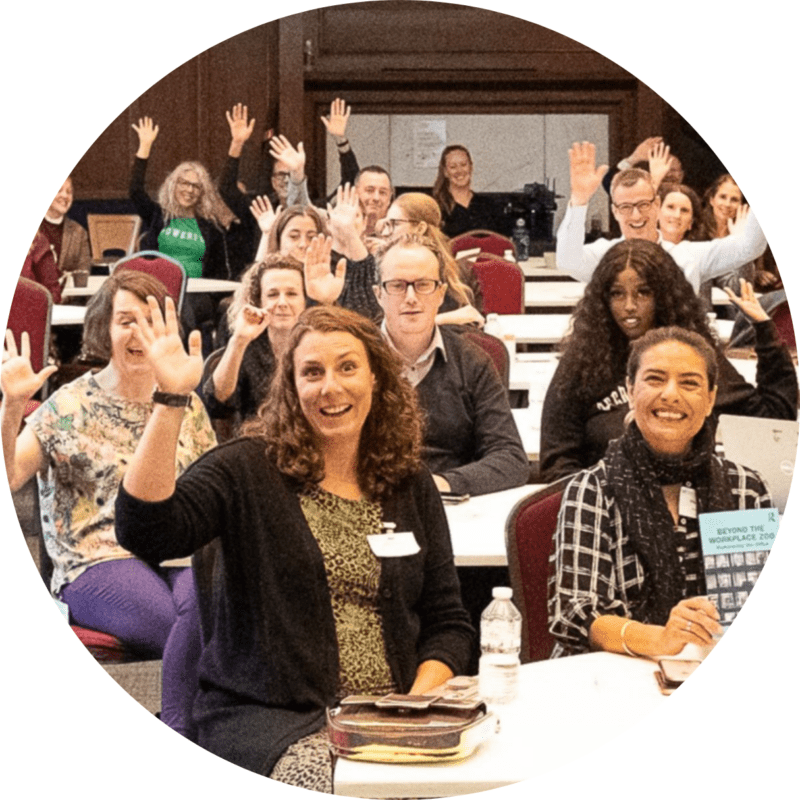Reclaiming Privacy in a Transparent World: Making Dens at Work

This innovative research, which will be presented at our upcoming Workplace Trends Research Summit on 19 April 2023, is based on a post-occupancy evaluation (POE) study of the Bristol Business School building – a flagship, largely open plan, space that aims to attract students, facilitate links with businesses and foster a collaborative space for staff to work together. The strategic aim of the building was that it should be ‘generative’ and was designed to link with the strategic vision: a building to support a community that is professionally engaged, vocationally relevant, internationally connected and academically strong.
Both core funders of this POE research project, ISG plc (construction) and Stride Treglown (architects) identified a need to undertake an original POE of the building in order to explore the user experience and use of the new space using a creative and innovative approach. Whilst more traditional POE approaches focus predominantly on the technical and functional performance of a building, they rarely gather detailed, subjective, in-depth data based on the user experience of the building. This POE research project fills this gap.
The project provides a nuanced, personal, emotional and sensory exploration of a flagship building, using modern visual methods: through the use of Instagram and participant-led photography.
The findings in this presentation emerge from an in-depth, user-centred, qualitative, sensory post-occupancy evaluation (POE) of a flagship building – Bristol Business School. The aim of the research was to investigate how the ethos of the building has impacted on user experiences of working, studying, and visiting it. Architecturally, the building provides considerable open, shared space not formally designated for particular activities. Walls and partitions are largely glass, with space arranged around a full height atrium, and central staircase affording expansive views through the building and the activities going on within it. This led us to question: How does a transparent, collaborative, flexible and open building affect working and studying practices? What influence does it have on users’ and is the building operating as predicted? (for example, has it been differently understood and/or experienced by users?). Traditional POE instruments do not gather this kind of information and so a secondary aim of the research was to experiment with visual and qualitative methodologies as effective vehicles for POE: What can we learn from this research that can help us develop and design buildings in the future? Only about 10% of our findings replicate areas covered by traditional POE, suggesting there is great utility in employing more qualitative approaches to POE guides.
Using innovative visual methods including Instagram, participant-led and participant-directed photography, alongside image-led discussion groups, data was collected over a full year cycle with over 250 participants contributing to the study; 30% staff, 60% students and 10% visitors. Building users were asked to submit photographs and captions of their spatial experiences in the building that addressed two simple questions:
- How are you using the building?
- How do you feel about the building?
The majority of users submitted their photographs and captions to the project team individually. Over 740 photographs were received in total.
In this presentation, I will be exploring how visual methods can tell us more about users’ lived experiences of a largely open plan workplace and will focus on findings from this research that centre, specifically, around visibility and transparency. Key findings highlight how open and expansive views afforded by glass are sometimes welcomed, but there is a need to balance visibility against individuals’ privacy when designing buildings of this kind. There are unintended effects of making work visible, and psychological and cultural implications arise from having bodies on display.
In order to unpack these findings, I will draw on research that examines the ‘glass cages and glass palaces’ of work (Gabriel, 2005), where open plan buildings such as these are so representative of present-day workplaces. The wider design narrative here is that openness and glass facades and huge atria speak of collaboration and togetherness and celebrating all that we do by putting it on display. Indeed, in the post-covid era, spaces for collaboration in the office are now considered by many a ‘must have’. Yet, the findings in this research suggest a different experience for users, where continuous visibility and transparency can evoke feelings of exposure and insecurity.
So, what is the response to this unforgiving gaze and continuous exposure? What do people do in response to these open spaces? Here, our data highlights how users feel, but what happens next? Interestingly in our data, we see subtle forms of resistance in the face of all this. Our findings point towards matters concerning power, privacy, and personalisation, and specifically how users of the building seek refuge in corners, nooks, and crannies, and how these rather unorthodox hiding places take on a den-like quality, providing important sites for learning, reflection, and seclusion.
I explore this idea of seeking refuge and hiding places using previous research on privacy at work (Shortt, 2015), as well as Sobel’s work on den-making behaviour (2020), as a way of understanding users’ response to continuous exposure in open plan and the ongoing intimate relations that organisations insist on encouraging though their narratives of collaboration and transparency. This is presented through three key themes; secrecy, placemaking, and security, and questions – is den-making part of contemporary workplace spatial practice? and what does this mean for creating inclusive workplaces for the future?
Dr Harriet Shortt
Associate Professor in Organisation Studies, Bristol Business School, University of the West of England and
Head of Visual Engagement, Bibo Studios
 Harriet is an academic, researcher, and workplace consultant in the field of spatial change and user experience. She has 17 years’ experience in researching and working with organisations exploring space, place, and the material world of work. She has expertise in qualitative research methods including visual, arts-based approaches to understanding user experiences of placemaking. She is often invited to comment on spatial change and working practices in the media and her research has been published in international journals and won awards for research excellence.
Harriet is an academic, researcher, and workplace consultant in the field of spatial change and user experience. She has 17 years’ experience in researching and working with organisations exploring space, place, and the material world of work. She has expertise in qualitative research methods including visual, arts-based approaches to understanding user experiences of placemaking. She is often invited to comment on spatial change and working practices in the media and her research has been published in international journals and won awards for research excellence.
Harriet is passionate about user experiences of buildings, places, and facilities and believes that successful placemaking encompasses an awareness of cultural shifts, diverse needs, innovative communications, and a sympathetic understanding of people and their everyday lives.
 Early bird rates for the Workplace Trends Research Summit on 19 April 2023 are currently available for a limited time only. For full information on the event click here, or to go direct to our booking page click here.
Early bird rates for the Workplace Trends Research Summit on 19 April 2023 are currently available for a limited time only. For full information on the event click here, or to go direct to our booking page click here.
